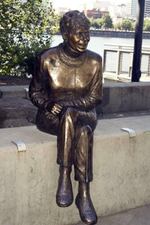
"Vera Katz", 2006, Bronze, 53" x 18" by 18" on Portland's Eastbank Esplanade.
Bill Bane / Courtesy of the Regional Arts and Culture Council
The late Vera Katz, in her three terms as Portland mayor, worked hard to make sure art would be part of Portland’s identity. Art wasn’t so much an item on Katz’s priority list as something to be incorporated in all facets of city business.
Eloise Damrosch was the longtime head of the Regional Arts and Culture Council. Linda K. Johnson is a dancer and choreographer, who has taught in many environments, including Jefferson High School in Portland. We asked them to come in and share with us what they remember about living, working and making in Vera Katz’s Portland.
1 | Building With Art
As a state legislator, Vera Katz pushed to pass Oregon's Percent for Art, which mandated construction budgets include cash for art and design as part of each capital project. (Multnomah County, Portland and other jurisdictions would follow suit.) When Katz took on ventures as Portland's mayor, such as the Eastbank Esplanade and the Portland Streetcar, these mechanisms were critical to putting public art front and center. Damrosch said, "We were able to afford some big pieces that we couldn't normally, with smaller projects."
2 | Finding the Money
3 | Mentoring Her Successors
While Katz did oversee the arts portfolio, she didn't dedicate a staffer as an arts liaison like her colleague Mike Lindberg did. However, Damrosch said Katz made a huge impact by mentoring her chief-of-staff, Sam Adams — who was himself elected to council in 2004 and mayor in 2008. Adams' laser-focus on arts issues led to a deepening of the city's commitments and funding. "He was truly what you can call an arts mayor," Damrosch said.
